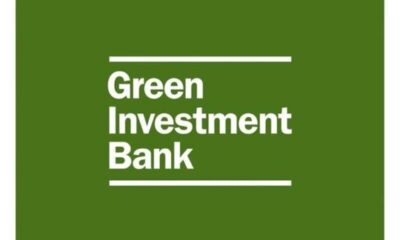Economy
The battle for the Green Investment Bank location: round one
The Government is expected to announce the location of the Green Investment Bank later this month. But where should it be? Blue & Green Tomorrow whittles the initial 32 bidding places down to 16, in round one of our recommendation series.
A lot of hope is placed on the shoulders of the Green Investment Bank (GIB). It is widely regarded as the ignition needed to transcend the UK economy towards a green and low-carbon future. However, its location is yet to be decided.
 The Government is expected to announce the location of the Green Investment Bank later this month. But where should it be? Blue & Green Tomorrow whittles the initial 32 bidding places down to 16, in round one of our recommendation series.
The Government is expected to announce the location of the Green Investment Bank later this month. But where should it be? Blue & Green Tomorrow whittles the initial 32 bidding places down to 16, in round one of our recommendation series.
A lot of hope is placed on the shoulders of the Green Investment Bank (GIB). It is widely regarded as the ignition needed to transcend the UK economy towards a green and low-carbon future. However, its location is yet to be decided.
A total of 32 towns and cities across the UK have bid to host the innovative project, but how is the Government meant to choose?
Whilst it’s likely that the city with the best PR campaign will get the nod, or which place business secretary Vince Cable most likes to visit, at Blue & Green Tomorrow, we’ve recognised the opportunity that the GIB brings with it.
Not only will it be the first step in securing a more sustainable economy, but the positive impact it will have on its eventual location cannot be stressed enough.
Therefore, we’ve hatched a cunning plan to recommend which city should be chosen, based on several key criteria.
In this introductory article, we’ll be shaving the 32 down to 16 by looking at each city’s carbon emissions. Let’s face it; it’d be rather contradictory to have a Green Investment Bank in a place that spewed excessive greenhouse gases.
But before we get into that, here are the 32 contenders:
Bicester, Birmingham, Brighton, Bristol, Cardiff, Chester, Cornwall, Coventry and Warwickshire, Derby, Durham, Edinburgh, Gloucester, Hull, Ipswich, Leeds, Leicester, Liverpool, London, Manchester, Milton Keynes, Newcastle, Norwich, Nottingham, Peterborough, Renfrewshire, Sheffield, Southampton, Stoke-on-Trent, Sunderland, Tees Valley, Torbay and Warrington.
As you can see, it’s quite a wide-ranging list. The heavyweights of London, Birmingham and Leeds find themselves up against smaller areas such as Bicester, Durham and Gloucester, whilst over 500 miles separates Cornwall and Renfrewshire – the furthest apart bidders.
We looked at how much carbon emissions each of the 32 bidding places produced in both 2005 and 2009. The results are per capita, which is the total amount divided by the population. This is what we found.
 Click to enlarge.Leeds came out as the undoubted frontrunner, as it was the lowest emitter in both 2005 and 2009. At the other end, Tees Valley, an amalgamation of Hartlepool, Middlesbrough, Redcar and Cleveland, and Stockton-On-Tees, was clearly the highest.
Click to enlarge.Leeds came out as the undoubted frontrunner, as it was the lowest emitter in both 2005 and 2009. At the other end, Tees Valley, an amalgamation of Hartlepool, Middlesbrough, Redcar and Cleveland, and Stockton-On-Tees, was clearly the highest.
In order to give improving areas a chance, we collated a second set of data at this stage, detailing which of the 32 places had improved their per capita carbon emissions level the most.
After all, the whole ethos behind our final decision was to recommend an emerging economy that would ultimately benefit from hosting the GIB.
Although the highest emitter in the previous chart, Tees Valley, had the second best reduction percentage behind first placed Norwich (24.6% reduction), with its emissions plummeting by an admirable 23.6%.
 Click to enlarge.Chester (5.8%), Stoke-on-Trent (11%) and Renfrewshire (11.6%) had improved the least out of the 32, but this didn’t mean they were automatically ruled out. Leeds for example, whilst the lowest emitter in both 2005 and 2009, had only improved by 13%.
Click to enlarge.Chester (5.8%), Stoke-on-Trent (11%) and Renfrewshire (11.6%) had improved the least out of the 32, but this didn’t mean they were automatically ruled out. Leeds for example, whilst the lowest emitter in both 2005 and 2009, had only improved by 13%.
In order to get a true reflection of the best 16 candidates, we merged the two sets of figures onto one chart, and included a knockout zone for the cities that didn’t quite make the cut.
At this point, it’d be helpful if you imagined an X Factor-style situation, complete with tense music and a screaming audience, with each of the 32 contenders lined up nervously on stage.
Handing over to Dermot O’Leary, areas that make it through to round two are…
 Click to enlarge.Brighton, Birmingham, Bristol, Cardiff, Gloucester, Hull, Ipswich, Leeds, Leicester, Manchester, Norwich, Nottingham, Sheffield, Southampton, Sunderland and Torbay.
Click to enlarge.Brighton, Birmingham, Bristol, Cardiff, Gloucester, Hull, Ipswich, Leeds, Leicester, Manchester, Norwich, Nottingham, Sheffield, Southampton, Sunderland and Torbay.
Congratulations to them, and commiserations to the unfortunate half that didn’t make it through. London, Edinburgh, Durham and, in particular, Newcastle were very close to progressing to the next stage, but ultimately missed out.
The lucky 16 advance to round two, where they will be again halved, but this time based on the size and development of their finance and insurance sectors.
Until then, why not have a read up about the GIB on the Department for Business, Innovation and Skills’ (BIS) website?
And if you’re interested in contributing to the prospect of a green economy, you can. Ask your financial adviser about the best ways to invest your money sustainably, or alternatively, fill in our online form and we’ll show you how.
Why should your city be home to the GIB? Comment on this article, or you can find us on Facebook and Twitter. We’d love to hear from you.
Here’s a round-up of Blue & Green’s GIB location battle so far.
 Click to enlarge.Infographics: Ben Willers. Picture source: Ryan Hyde.
Click to enlarge.Infographics: Ben Willers. Picture source: Ryan Hyde.


 Environment10 months ago
Environment10 months agoAre Polymer Banknotes: an Eco-Friendly Trend or a Groundswell?

 Environment12 months ago
Environment12 months agoEco-Friendly Home Improvements: Top 7 Upgrades for 2025

 Features9 months ago
Features9 months agoEco-Friendly Cryptocurrencies: Sustainable Investment Choices

 Features10 months ago
Features10 months agoEco-Friendly Crypto Traders Must Find the Right Exchange






























